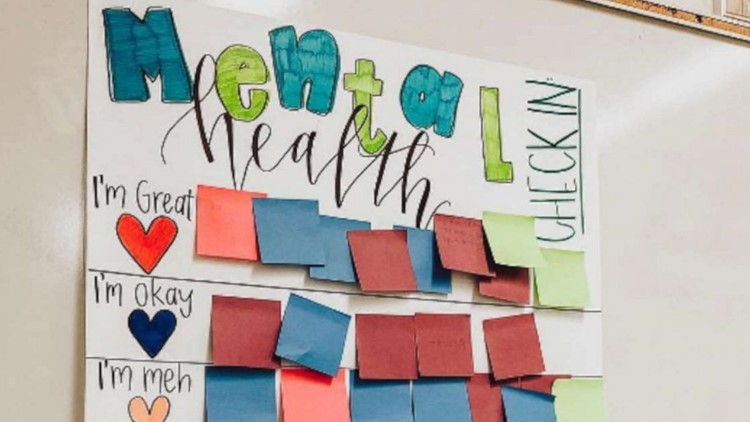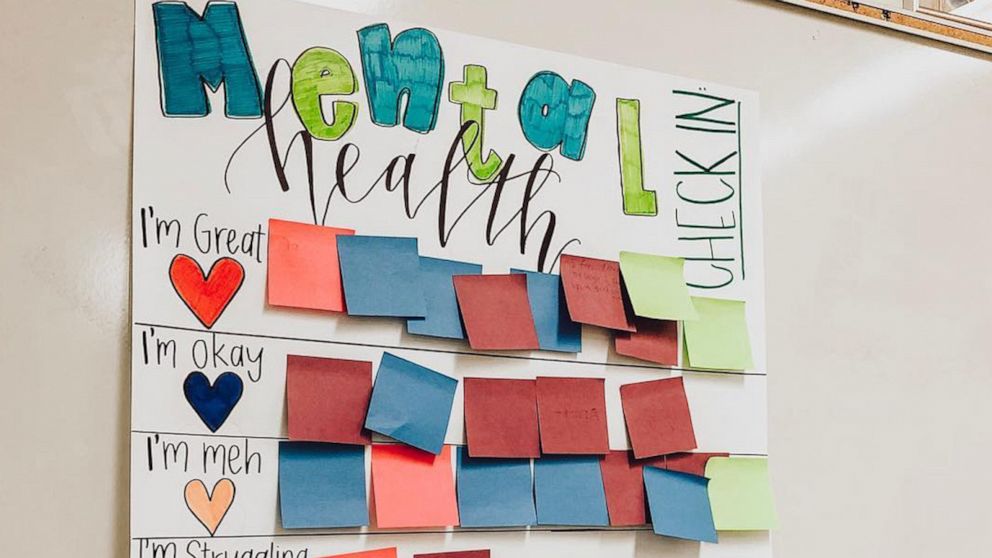CALIFORNIA, USA — (ABC News)--A teacher has come up with a clever idea to ensure her students have a safe place to share their feelings.
Erin Castillo, an educator at John F. Kennedy High School in Freemont, California, created a mental health check-in chart for her students. Now, she's inspiring teachers around the globe to make their own versions of the chart for their classrooms.
"I never expected it to get beyond my following," Castillo told "Good Morning America" of her chart, which was originally posted on her Instagram page. "To see this being used in multiple countries around the world, having [teachers] reach out from New Zealand and Africa...to hear actual stories of people helping their students, I'm really overwhelmed with joy."
Castillo is an English and peer counseling teacher. She said a friend and fellow teacher launched a mental health community for teachers on Facebook, which inspired her to create a platform her students could use in the classroom.
When using the check-in chart, students are encouraged to grab a post-it, write their name on the back and place it next to the statement that best matches their feelings for the day.
Castillo said her students chose to write their names on the back of the post-its and trust one another to not invade privacies.
The options are, "I'm great", "I'm okay," "I'm meh," "I'm struggling," "I'm having a hard time and woudn't mind a check in" or "I'm in a really dark place."
The last two statements merit a check-in with Castillo and a follow-up converstaion with the counselor or the school psychologist on campus, Castillo said.
"I've had a lot of students in the last five years of my career that have struggled with self-confidence, self-doubt, image, had suicidal thoughts, attempted suicide and, after seeing all that, I've been making it a theme in my classroom and trying to check in with them," she added.
Dr. Stephanie Samar, a clinical psychologist at the Mood Disorders Center of the Child Mind Institute and certified school psychologist, told "GMA" that the chart is a positive resource for teens in more ways than one.
"In a way it's destigmatizing by having the adults say, 'It's OK to be struggling. We're here for you,'" Samar said. "It gives the checks and balances that everyone isn't fine all the time — the way that social media and YouTube and all these platforms make it seem. Seeing their classmates having good days and bad days really taps into what reality is."
"Asking for help is very difficult, especially for kids," Samar added. Taking the onus off of them to [admit] they need help will facilitate them actually getting help. It's a lot easier for them to put a post-it on a board."
But the chart isn't just for emotional help. Castillo said it's served as a tool for teens to ask for academic assistance as well.
"I'll have a student that will be struggling with something I'm teaching and they'll put a post-it up instead of raising their hand," Castillo said.
Castillo shared a photo of her chart with her 24,000 Instagram followers and it was later reposted by a suicide prevention and awareness group on Facebook.
Now, she's being tagged by teachers who are creating their own.
Kyler Olson a fourth-grade teacher from North Dakota, created a mental health check-in board after finding Castillo's on social media.
"It has shown my students that I'm not just here to help them academically," Olson told "GMA." It has really brought [attention] to me which [of my] students need me the most, emotionally."
Castillo also created a downloadable poster, which also includes talking points that her school psychologist and a counselor helped her write. Castillo encourages fellow educators to speak to their students about the purpose of the chart before hanging it up.
"If it can help one student, then it'd be better than where we're at now," Castillo said. "I hope it gets to a place where we can talk about our struggles openly and our mental health. This looks like a step in the right direction."
Anyone in crisis or who knows someone in crisis, please call the National Suicide Prevention Lifeline at 1-800-273-TALK (8255) or contact the Crisis Text Line by texting TALK to 741-741.




